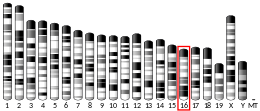Kalirin
Kalirin, also known as Huntingtin-associated protein-interacting protein (HAPIP), protein duo (DUO), or serine/threonine-protein kinase with Dbl- and pleckstrin homology domain, is a protein that in humans is encoded by the KALRN gene.[5][6] Kalirin was first identified in 1997 as a protein interacting with huntingtin-associated protein 1.[5] Is also known to play an important role in nerve growth and axonal development.[7]
Kalirin is a member of the Dbl family of proteins and is a Rho guanine nucleotide exchange factor.
It is named after the multiple-handed Hindu goddess Kali for its ability to interact with numerous other proteins. Kalirin's other name, DUO, comes from the fact that it is 98% identical to rat DUO protein and 80.6% identical to a human protein named TRIO. Unlike TRIO, which is expressed in numerous tissues, Kalirin isoforms are mainly found in the brain.
Clinical significance
Several isoforms of Kalirin are produced through alternative splicing.[8] One of the isoforms, Kalirin-7, was found to be necessary for the remodeling of synapses in mature cortical neurons and is thought to be important in the development of schizophrenia,[9][10][11][12] as demonstrated by adolescent development of schizophrenia-like symptoms in kalirin knockout mice.[13] Alzheimer's disease may also be linked to kalirin-7.[12][14][15]
References
- GRCh38: Ensembl release 89: ENSG00000160145 - Ensembl, May 2017
- GRCm38: Ensembl release 89: ENSMUSG00000061751 - Ensembl, May 2017
- "Human PubMed Reference:". National Center for Biotechnology Information, U.S. National Library of Medicine.
- "Mouse PubMed Reference:". National Center for Biotechnology Information, U.S. National Library of Medicine.
- Colomer V, Engelender S, Sharp AH, Duan K, Cooper JK, Lanahan A, Lyford G, Worley P, Ross CA (September 1997). "Huntingtin-associated protein 1 (HAP1) binds to a Trio-like polypeptide, with a rac1 guanine nucleotide exchange factor domain". Hum. Mol. Genet. 6 (9): 1519–25. doi:10.1093/hmg/6.9.1519. PMID 9285789.
- Kawai T, Sanjo H, Akira S (February 1999). "Duet is a novel serine/threonine kinase with Dbl-Homology (DH) and Pleckstrin-Homology (PH) domains". Gene. 227 (2): 249–55. doi:10.1016/S0378-1119(98)00605-2. PMID 10023074.
- Chakrabarti K, Lin R, Schiller NI, Wang Y, Koubi D, Fan YX, Rudkin BB, Johnson GR, Schiller MR (June 2005). "Critical role for Kalirin in nerve growth factor signaling through TrkA". Mol. Cell. Biol. 25 (12): 5106–18. doi:10.1128/MCB.25.12.5106-5118.2005. PMC 1140581. PMID 15923627.
- McPherson CE, Eipper BA, Mains RE (February 2002). "Genomic organization and differential expression of Kalirin isoforms". Gene. 284 (1–2): 41–51. doi:10.1016/S0378-1119(02)00386-4. PMID 11891045.
- Xie Z, Srivastava DP, Photowala H, Kai L, Cahill ME, Woolfrey KM, Shum CY, Surmeier DJ, Penzes P (2007). "Kalirin-7 controls activity-dependent structural and functional plasticity of dendritic spines". Neuron. 56 (4): 640–56. doi:10.1016/j.neuron.2007.10.005. PMC 2118058. PMID 18031682.
- Ma XM, Kiraly DD, Gaier ED, Wang Y, Kim EJ, Levine ES, Eipper BA, Mains RE (November 2008). "Kalirin-7 is required for synaptic structure and function". Journal of Neuroscience. 28 (47): 12368–82. doi:10.1523/JNEUROSCI.4269-08.2008. PMC 2586970. PMID 19020030.
- Sommer JE, Budreck EC (April 2009). "Kalirin-7: linking spine plasticity and behavior". Journal of Neuroscience. 29 (17): 5367–9. doi:10.1523/JNEUROSCI.0235-09.2009. PMC 2684031. PMID 19403804.
- Penzes P, Jones KA (August 2008). "Dendritic spine dynamics--a key role for kalirin-7". Trends in Neurosciences. 31 (8): 419–427. doi:10.1016/j.tins.2008.06.001. PMC 3973420. PMID 18597863.
- Cahill ME, Xie Z, Day M, Barbolina MV, Miller CA, Weiss C, Radulovic J, Sweatt JD, Disterhoft JF, Surmeier DJ, Penzes P (July 2009). "Kalirin regulates cortical spine morphogenesis and disease-related behavioral phenotypes". Proceedings of the National Academy of Sciences of the United States of America. 106 (31): 13058–63. doi:10.1073/pnas.0904636106. PMC 2722269. PMID 19625617.
- Youn H, Ji I, Ji HP, Markesbery WR, Ji TH (November 2007). "Under-expression of Kalirin-7 Increases iNOS activity in cultured cells and correlates to elevated iNOS activity in Alzheimer's disease hippocampus". J. Alzheimers Dis. 12 (3): 271–81. PMID 18057561.
- Youn H, Jeoung M, Koo Y, Ji H, Markesbery WR, Ji I, Ji TH (June 2007). "Kalirin is under-expressed in Alzheimer's disease hippocampus". J. Alzheimers Dis. 11 (3): 385–97. PMID 17851188.
External links
- Traffic jam in brain causes schizophrenia symptoms
- Architect of Synaptic Plasticity Links Spine Form and Function - Schizophrenia Research Forum, 2007-11-30



